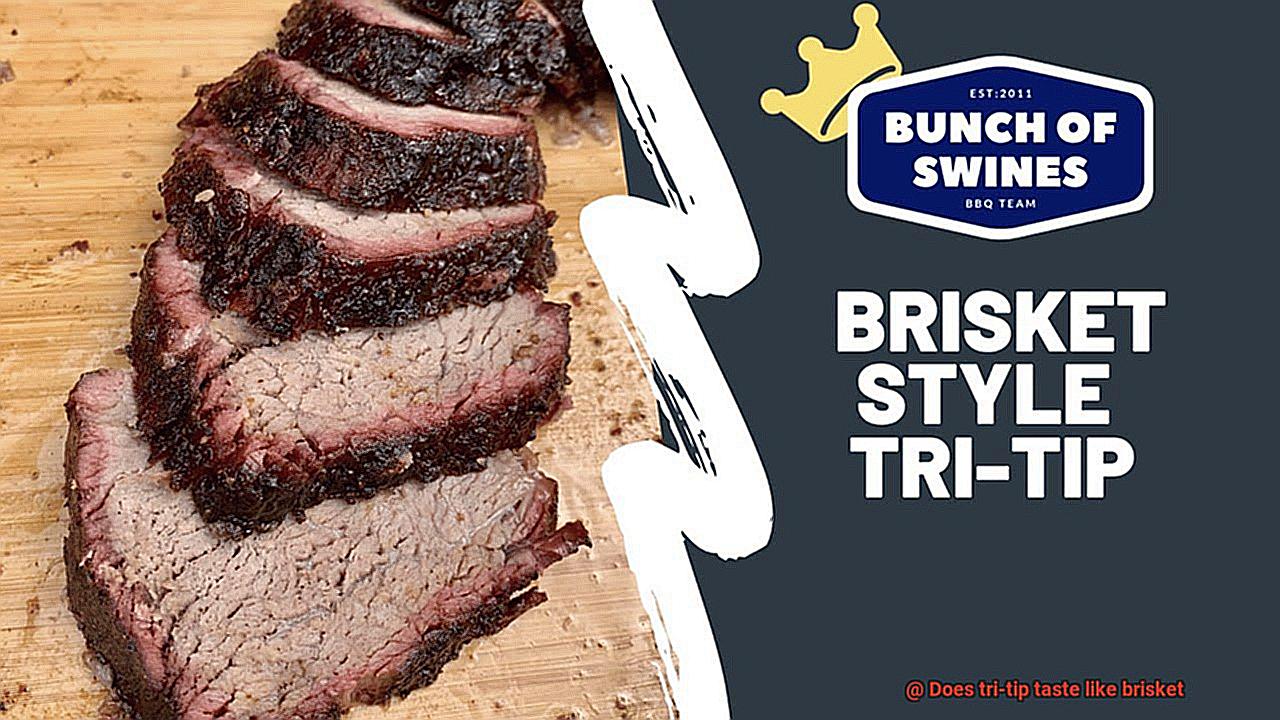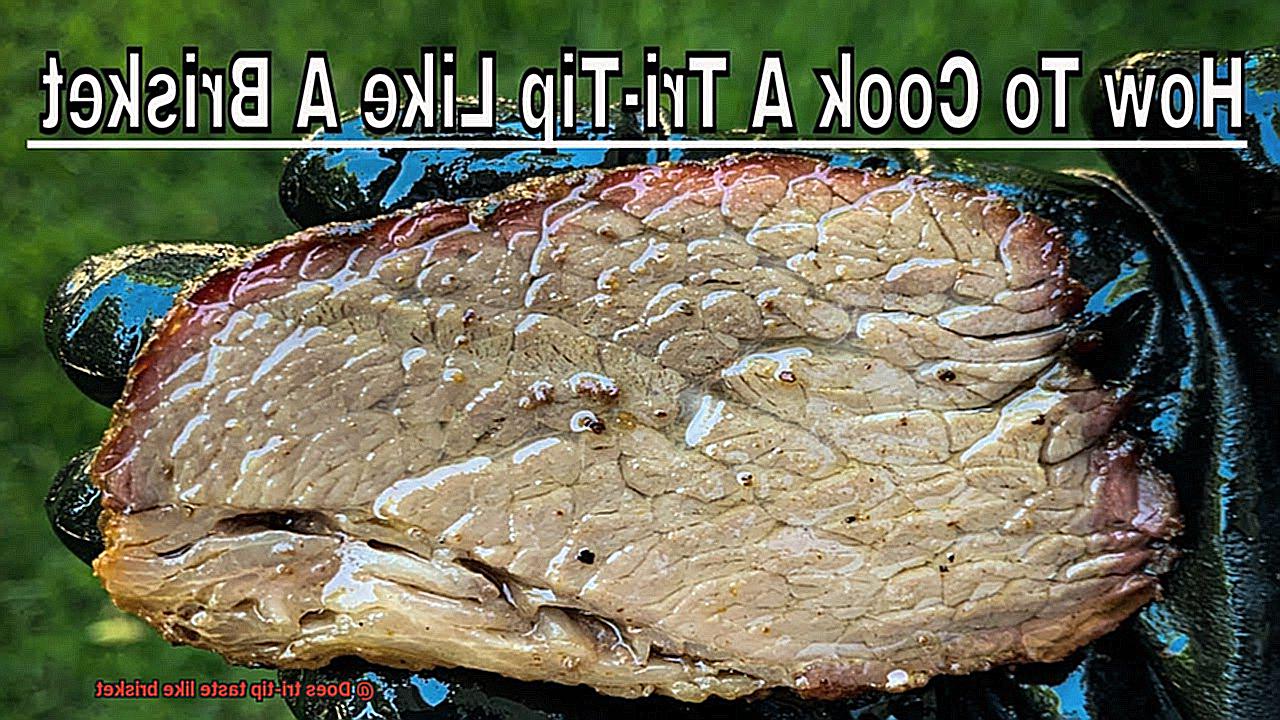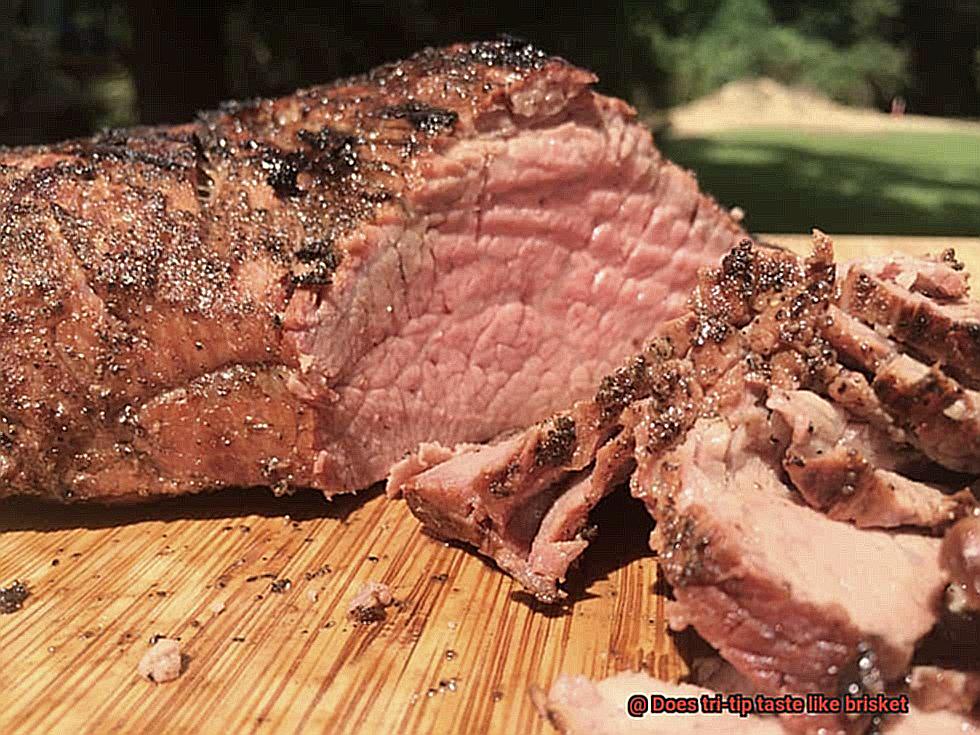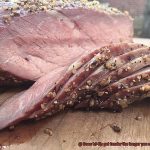Are you tired of the same old meats at your barbecue parties? Bored of burgers and hot dogs? It’s time to spice things up and try something new. Today, we’re delving into the world of tri-tip and brisket. Both cuts have gained popularity among meat lovers, but the big question is: Does tri-tip taste like brisket?
For years, brisket has been the star of barbecue dishes. Pitmasters swear by it, and it’s known for its strong and smoky flavor. But recently, tri-tip has been gaining traction in the BBQ world. This triangular cut of beef comes from the bottom sirloin and boasts a tender texture with a meaty flavor that many enjoy.
While both cuts are perfect for low and slow cooking on the grill or smoker, they have distinct differences in flavor profiles, cooking techniques, and origins. In this article, we’ll explore these similarities and differences between tri-tip and brisket. We’ll discuss their taste, texture, and cooking methods so you can decide which one suits your preferences best for your next barbecue party.
If you’re a meat lover looking to expand your knowledge (and taste buds), then keep reading to find out whether tri-tip tastes like brisket or not – because there’s nothing better than discovering new meats to add to your grilling repertoire.
Contents
What is Tri-Tip?
This triangle-shaped cut of beef is sourced from the bottom sirloin and is popularly grilled or smoked, particularly in California where it’s known as a “Santa Maria steak”. The name Tri-tip comes from its triangular shape, which sets it apart from other cuts of beef.
While Tri-tip may not be as fatty as other cuts, it has a distinct flavor that makes it a unique gastronomic experience. Its mild and beefy taste has an earthy undertone that can be seasoned with various marinades and seasonings. This lean cut is perfect for those who are watching their fat intake but still want to enjoy the succulence of beef.
When cooking Tri-tip, it’s crucial to keep in mind that it can be tough if not cooked properly. It’s recommended to cook it medium-rare to medium and let it rest for at least 10 minutes before slicing to allow the juices to redistribute, making the meat tender and juicy.
Although Tri-tip and Brisket are both cuts of beef, they have distinctive differences in terms of flavor and texture. While Brisket has a rich smoky taste, Tri-tip has a mild flavor that makes it adaptable to various marinades. Both cuts can be grilled or smoked, but Tri-tip’s leaner texture makes it a more versatile option.
What is Brisket?

Brisket is a large, tough piece of meat that comes from the breast or lower chest of a cow. It’s a challenging cut to prepare, but when done right, it can be incredibly delicious. Brisket requires slow-cooking and low heat to make it tender and flavorful, which is why it’s often associated with Texas-style barbecue.
Now let’s get into the details – there are two main parts to a brisket: the point and the flat. The point is the thicker, fattier end of the brisket, while the flat is leaner and thinner. The point is known for its rich flavor and moist texture, while the flat is prized for its tenderness. Both parts are equally delicious, but they require different cooking techniques.
The preparation process for brisket is an art. It’s typically rubbed with a blend of spices before being cooked slowly over wood or charcoal for anywhere from 8-16 hours. The cooking time depends on the size of the brisket and the cooking temperature. When done correctly, brisket should be tender and juicy with a deep smoky flavor.
So how do you serve this mouth-watering cut of meat? Brisket can be sliced or chopped and served on its own or as part of a sandwich or taco. It’s often accompanied by barbecue sauce or other condiments, making it even more flavorful.
Differences in Taste and Texture
Well, today we are going to explore the tantalizing world of taste and texture differences between two scrumptious cuts of beef – tri-tip and brisket. As an expert in this field, I am excited to share with you some fascinating insights.
- Let’s start with tri-tip – a lean cut of beef that comes from the bottom sirloin. The mild flavor and tenderness of this cut make it perfect for grilling. When cooked to perfection, it has a slightly smoky taste and a tender texture that will leave you wanting more. Picture yourself sinking your teeth into a juicy piece of tri-tip with a hint of smoke flavor – simply divine.
- On the other hand, we have brisket – a cut that comes from the chest or breast of the cow and has a higher fat content. This extra fat gives brisket its rich, beefy flavor and its tender, melt-in-your-mouth texture when cooked low and slow. The process of smoking the brisket with a blend of spices over wood or charcoal for up to 16 hours creates an explosion of flavors that will leave your taste buds dancing.
But that’s not all. Tri-tip and brisket also differ in their grain structure. Tri-tip has a tighter grain than brisket, which means that it can be sliced more easily against the grain without falling apart. Brisket has a looser grain that requires careful slicing to maintain its shape and texture.
Similarities in Cooking Methods
These two types of beef may have distinct textures and flavors, but they share some similarities in their cooking methods that are sure to tantalize your taste buds.
First and foremost, both tri-tip and brisket require the low and slow cooking method to reach their full potential in terms of tenderness and flavor. This means cooking them at a low temperature for an extended period of time, which allows the meat to develop its distinct taste and texture. So, don’t rush the process – let these cuts cook slowly and savor the result.
Seasoning is also a crucial factor in preparing both tri-tip and brisket. To bring out the natural flavors of the meat, it’s essential to use a rub or marinade before cooking. This not only enhances the taste but also helps to tenderize the meat, making it even more enjoyable to eat.
When it comes to cooking techniques, both tri-tip and brisket can be prepared using various methods such as grilling, roasting, or smoking. However, smoking is often recommended for these cuts as it allows for slow cooking that brings out their rich flavors. This method infuses the meat with smoky goodness while keeping it moist and tender.
Flavor Profile of Tri-Tip
This lean cut of beef has a slightly robust and beefy flavor, but it doesn’t have the same richness as brisket due to its lower fat content.
But don’t let this fool you. With the right preparation, tri-tip can be just as flavorful and tender as its fatty cousin. The key is to generously season it with herbs and spices and cook it to perfection. You can grill it for a slightly charred and smoky flavor, smoke it for a deep and complex smokiness that permeates the meat, or roast it in the oven for a juicy, rich beefy taste.
Unlike brisket, which has a dominant beefy flavor, tri-tip has a milder taste that allows for more versatility in seasoning. Its subtle beefiness pairs well with a range of herbs and spices like rosemary, garlic, cumin, paprika, and black pepper. This opens up endless opportunities for experimentation with your favorite flavors.
Flavor Profile of Brisket
If you are seeking a flavor experience that is both complex and mouthwatering, then look no further than brisket. This popular cut of beef, obtained from the cow’s chest, is known for its rich, smoky, savory, and slightly sweet taste. As an expert in the flavor profile of brisket, I can tell you that it’s not just one factor that makes this meat so irresistible. Rather, it’s a combination of elements that come together in perfect harmony to create an unforgettable culinary experience.
First and foremost, brisket is a tough cut of meat that requires low and slow cooking to break down its connective tissue and make it tender and juicy. The smoky flavor of brisket comes from hours of cooking over wood or charcoal, which infuses the meat with a deep, robust flavor that cannot be replicated by any other method. This smokiness is a defining characteristic of brisket and sets it apart from other cuts of beef.
In addition to the smokiness, brisket has a savory taste due to the umami-rich compounds present in the meat. These compounds are responsible for the meaty taste that makes brisket so satisfying. Finally, the sweetness in brisket comes from the caramelization of natural sugars during cooking. This process creates a crispy bark on the outside of the meat that is full of flavor. It’s worth noting that many recipes call for a sweet glaze or rub to be applied to the meat before cooking, adding yet another layer of sweetness to the final dish.
What truly distinguishes brisket, however, is how these flavors come together to create a unique taste experience. The smokiness and sweetness balance out the savory flavors perfectly, creating a harmony that is both satisfying and delicious. For those who enjoy experimenting with different seasonings and cooking techniques, brisket offers endless possibilities.
Marinating and Seasoning Tips for Tri-Tip

Tri-tip is a versatile and flavorful cut of beef that can be elevated to the next level with proper marinating and seasoning techniques. This blog post will delve into five essential tips for achieving a mouth-watering tri-tip that will leave your taste buds singing.
Tip 1: Choose the Right Marinade
Marinating your tri-tip is a great way to infuse it with flavor and tenderness. Since tri-tip is a lean beef cut, it can easily become dry and tough if not marinated adequately. Your marinade should have an acidic component, such as red wine, soy sauce, Worcestershire sauce, or citrus juice, that breaks down the meat fibers. You can also add herbs like rosemary, thyme, or garlic for extra flavor. Experiment with different marinades to find the perfect one for your taste.
Tip 2: Season Generously
Tri-tip has a mild taste profile that can be enhanced by seasoning generously. A dry rub consisting of spices like paprika, chili powder, cumin, salt, and pepper is an excellent option for seasoning your tri-tip. Alternatively, you can go for a wet rub that combines similar ingredients to create a paste-like consistency. Whatever seasoning method you choose, make sure to coat all sides of the meat thoroughly.
Tip 3: Allow Enough Time for Marinating
To get the most flavor and tenderness out of your tri-tip, it’s essential to allow enough time for marinating. While two to four hours is the ideal time frame for marinating tri-tip, you can go up to 24 hours for maximum flavor penetration. Remember that anything over 24 hours may result in an overly acidic taste and mushy texture.
Tip 4: Rest Your Tri-Tip After Cooking
After cooking your tri-tip, let it rest for at least ten minutes before slicing it. This will help redistribute its juices evenly throughout the meat, making it juicy and tender. Also, slice the meat against the grain to ensure it remains tender.
Tip 5: Experiment with Different Cooking Methods
Tri-tip can be cooked using various methods, including grilling, smoking, and roasting. Each method produces a slightly different flavor profile and texture, so experiment to find what suits your taste buds. Grilling tri-tip over high heat is a popular option that creates a charred crust and smoky flavor.
Bold Flavors that Pair Well with Brisket
Let’s start with the basics. Brisket is rich and savory, so it needs strong and robust flavors that can stand up to its intensity. Here are some of the top bold flavors that go well with brisket:
- Smoky flavors: Since brisket is often cooked low and slow over wood or charcoal, it already has a smoky flavor. But why stop there? Enhance its natural smokiness with some smoked paprika, chipotle peppers, or hickory smoke for that extra oomph.
- Spicy flavors: The heat from spicy flavors can complement the richness of brisket and take it to the next level. Jalapenos, cayenne pepper, or hot sauce can add a kick of heat to the dish without overwhelming the meat.
- Tangy flavors: A bit of acidity can cut through the richness of brisket and provide a refreshing balance. Vinegar-based sauces, pickled onions, or citrus juices like lemon or lime can give that tangy twist that your taste buds crave.
- Sweet flavors: Adding sweetness to brisket can help balance out its saltiness and create a harmonious blend of flavors. Brown sugar, molasses, honey, or fruit-based sauces like BBQ sauce can add a touch of sweetness that pairs perfectly with this meat without making it cloying.
- Herbs and spices: Brisket can benefit from the complexity that herbs and spices bring to the table. Rosemary, thyme, garlic, or onion powder can add layers of flavor that take your brisket to new heights.
lrBI9CCjPRc” >
Conclusion
In conclusion, while tri-tip and brisket are both mouthwatering beef cuts that can be cooked in many ways, their flavor profiles, cooking techniques, and origins differ significantly. Tri-tip is a leaner cut with a subtle beefy taste that’s perfect for grilling and can be customized with different marinades and seasonings. On the other hand, brisket is a larger, tougher cut that requires slow cooking to make it tender and flavorful. It boasts a rich smoky taste with savory and sweet notes that blend together beautifully.
For those who want to experiment with marinades and seasonings on tri-tip, it’s essential to select the right marinade, season generously, marinate for an adequate amount of time, rest after cooking, and try out different cooking methods to achieve optimal results. For those who love bold flavors in their dishes, adding smoky, spicy, tangy, sweet flavors along with herbs and spices can enhance the natural richness of brisket.
To summarize, whether you prefer the mild flavor of tri-tip or the rich smokiness of brisket depends on your personal preferences. Both cuts offer unique gastronomic experiences that will tantalize your taste buds. So why not switch things up at your next barbecue party by trying out these delicious cuts?






